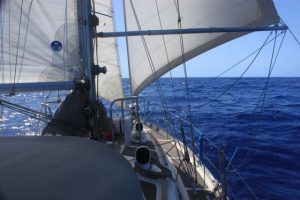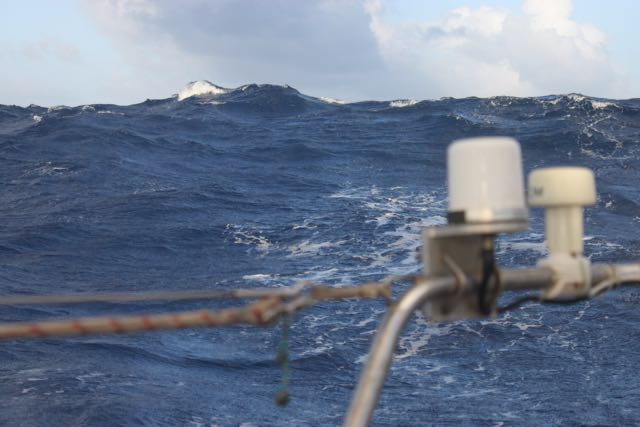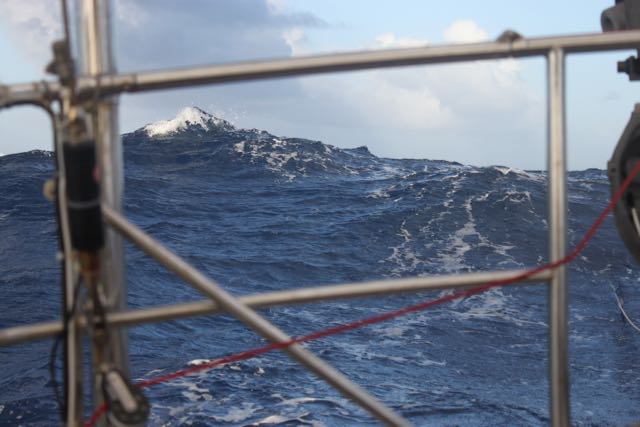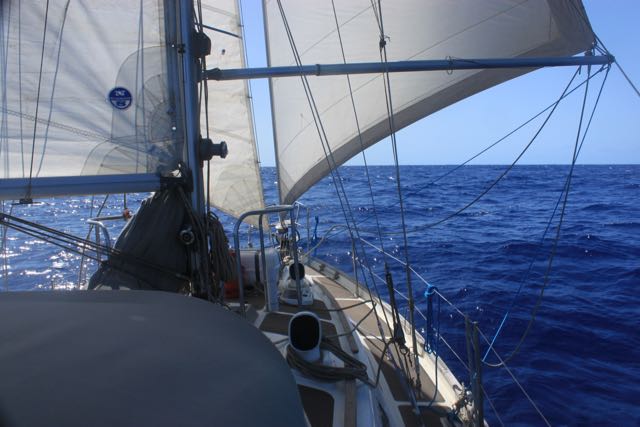
Transatlantic in Hindsight
I arrived at Barbados on 2nd March 2017, 21 days after leaving the Cape Verdes. So, how was it? How was this voyage, for so long anticipated, planned and feared?
I’ve allowed a while to pass before writing the answer in case the passage of time allowed a longer view to emerge. But actually I think now just as I did on arrival: the voyage was disappointing. Disappointment is a function of expectation and it’s possible my expectations were too high but I don’t think they were. Reading through my log I see day after day with true wind speeds of force six or more with occasional interludes of force five or less. That’s more than the pilot books say is average and more than I’d expected. The sea was rougher too. In the past I’ve found the famous big Atlantic swell to be something to marvel at but of little consequence. This time it made life difficult. Previously the time between successive peaks, the swell period, has been so long that the boat simply went slowly up and down. This time the swell period was much shorter and the motion sometimes quite violent, especially when there were two or more swells from different directions interacting with each other.

Atlantic Swell
Before my departure from the Cape Verdes I spent a lot of time with with the crews of three other boats. We left the Cape Verdes within days of each other and arrived at Barbados at much the same time, so we’d had pretty much the same conditions on the way. When we all got together at Barbados and compared notes it seemed we’d all experienced those conditions similarly, too. It was just a little too rough for comfort. The wind and seas only had to go down slightly and the world suddenly became a better place. There were interludes like that, and they were wonderful. But I was expecting force five to be the norm with occasional periods of six or seven, not the other way around. So, my passage became a means to an end, just getting from where I was to where I wanted to be, to be endured rather than relished. Perhaps my expectations were too high, but others who crossed before me and have done so since report very different conditions to those experienced by my friends and me so I think we were just unlucky.

Atlantic Swell 2
Apart from that, I’m glad to say the voyage was a success. I arrived safely. I also nearly made it all the way across without a single gear failure but in the last twelve hours of the trip a blade on the towed generator broke and the auto-pilot’s mounting pin sheared-off. Gratifyingly, I had spares in both cases and was able to make repairs while underway. Moreover, many of the modifications I’ve made to Moonrise were done with big ocean passages in mind and I was pleased at how well they worked out. I’m writing the “About the Boat” pages of this site at the moment so I shan’t repeat here what I’m saying there.
So now I’m in the Caribbean and a new phase begins. With the ocean crossing behind me I can relax and potter about the islands for the next couple of months.
Lessons Learned
I used almost exactly 100 litres of fresh water for the crossing and the first five days in Barbados. Four litres a day is less than I’d expected and less than the commonly quoted figure of five litres per day. I used fresh water for drinking and cooking and occasionally for washing dishes. Mostly I did the dishes in salt water and I washed in it too. The weather wasn’t particularly hot so I may not have been dinking as much as I would have if it had been, but I didn’t economise. I just drank what I wanted and used as much as was required for cooking.
I could have done with more food that’s easy to cook and eat. Almost all of my food, both in port and at sea, is simple but made from base ingredients. Cooking is required. In the past this has been fine. It’s been easy enough to cope with the odd few days of rough conditions. But when the weather makes cooking difficult for protracted periods then a few more easily prepared meals would have been very welcome.
I sailed directly from the Cape Verdes to Barbados and I’m glad I did. Some people sail all over the ocean looking for less wind, or more wind, or better wind, or whatever, and I suppose if you have a fast boat and accurate forecasts this might be effective. But without both of those (and I have neither) it makes more sense to use pilot charts rather than forecasts for longer voyages.
The question of when to leave was as tricky as it always is. I like to have good weather to begin with so that I get an easy start in which to find my sea legs. Forecasts are fairly reliable for three or four days but not for any further ahead than that so in the past I’ve decided that the thing to do is to wait until three or four days of good weather are forecasted and then go, regardless of what’s forecasted to follow. However, not only is this an unsatisfactorily simplistic rule of thumb I also find it a hard one to follow. It just seems wrong to set out when bad weather is forecasted for five or six days time. So on this occasion I once again waited for ages for a good long term forecast only to find that it was wrong after a few days, and once again concluded in hindsight that I should go when three good days are forecast. It remains to be seen if I actually have learned this lesson this time.

Sailing Down the Trades
James
Just seen this post.
Congratulations!!! A fantastic achievement. I hope to follow in your footsteps.
Force 7 most of the time must have been interesting.
David
That doesn’t sound like much fun (though given my terror last time we went out in the Channel, it’s hardly surprising that huge Atlantic swells don’t make me go ooh I’d like to try that!) – has it dampened the trip as a whole, or just that section? Are you still bumming around the Caribbean?